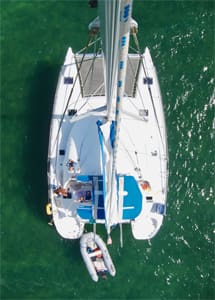Erik and Emily Orton moved their small family of four to New York City straight out of college for Erik to pursue a career in the Broadway theater industry. Over the next decade, Erik progressed from preparing payroll for Broadway shows to producing an off-Broadway musical, and even winning an Emmy when a musical he wrote was filmed for TV. Emily chose to stay home with their growing family of, now, five children.
Like much of the U.S., 2008 was an unexpected squall of financial uncertainty for Erik, Emily and their five children. Erik wrote during the day and worked a temp job in Manhattan’s financial district at night to make ends meet. Emily, a certified teacher, had recently started homeschooling, and their baby daughter was diagnosed with Down syndrome.
Now in their 30s, the Ortons realized how quickly their children were growing up. They had wonderful friends, a great neighborhood and a supportive faith community. But they began to discuss how to disrupt themselves, on purpose, as a family. Neither had sailing experience and both felt it was a leisure activity for the rich, but a sailing school on the Hudson River near Erik’s night job changed that paradigm.
When Erik walked into the sailing school, the Ortons weren’t planning to become cruisers. They didn’t even know that was an option. They took one step at a time, starting with ASA 101. After two years of sailing, they decided they wanted to live aboard for a year as a family before their oldest, then 14, left for college and their dream began in earnest. In 2014, they purchased an ex-charter catamaran and moved aboard. They both write about what happened next in their memoir, Seven at Sea: Why a New York City Family Cast Off Convention for a Life-Changing Year on a Sailboat.
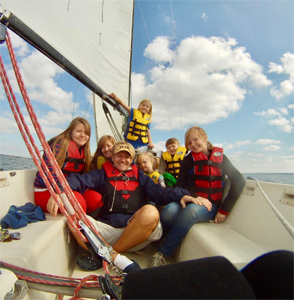 |
|
The Orton family daysailing on Long Island Sound. From left are Karina, Emily, Erik, Lily, Eli, Alison, and in the back, Sarah Jane. |
|
Erik Orton |
OV: How do you approach the subject of safety? Has your experience sailing offshore affected your thinking on safety?
EO: We don’t claim to be safety experts, but we try to be responsible.
I remember the first time I went offshore. I was helping friends deliver their 65-foot MacGregor from Annapolis to Rockland, Maine. We cut out from the Delaware River to Montauk. I went below for a nap and when I came above deck I was barely able to see shore. It was a mind shift for me to be that far out to sea. I was grateful I was having that experience with someone else as captain. That trip was also my first time doing overnight watches, sailing through fog, dodging lobster pots and generally expanding my spectrum of experiences and skills.
Fast forward a few years, after getting certified in ASA 101, 103, 104 and 105, and doing a few charters to test-sail different boats, we bought a catamaran — a Lagoon 380. I know the monohull vs. catamaran topic is hotly debated, but for us that decision was largely for comfort and safety. We planned to sail for a year with our five children, ages 6 to 16, one with Down syndrome. I liked the idea of the redundancies in a catamaran. If one engine failed, we had a backup. If we had a problem with one hull, the other was a “backup.”
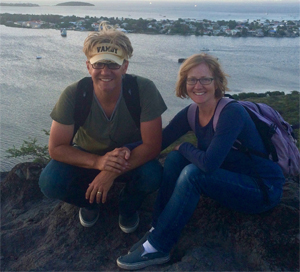 |
|
Erik and Emily at St. Martin in the Caribbean. |
|
Sarah Jane Orton |
OV: What planning did you do for a possible medical emergency? Did you receive any medical training before you began voyaging?
EO: I am an Eagle Scout with lots of first-aid training. I previously lifeguarded and was CPR certified. Emily and our oldest daughter took CPR courses, and Emily is extremely competent in first aid. The oldest three girls received basic first-aid training annually from a certified nurse. Emily consulted with our primary care physician as well as the kids’ pediatrician. She haunted Facebook groups like “Women Who Sail” and “Kids 4 Sail.” She downloaded and read the medical manual from Doctors Without Borders.
Emily prepped a medical supply kit that included splints, large bandages, painkillers, decongestants and even the ingredients to make our own sunscreen with zinc and honey pellets. We looked into EpiPens; they were expensive as well as unreliable since the person administering the shot can’t actually see if the needle has gone in far enough. Emily had been trained by nurses to administer shots for a previous concern with one of our children, and our pediatrician said epinephrine was the same ingredient as an Epipen, so we went with a generic approach. Our pediatrician gave us a prescription and some syringes. We bought a box of 16 doses of epinephrine from our pharmacy for less than $25.
Our only actual medical needs while living aboard were for sunburn, one cut pinkie toe and one mild case of heat stroke, which was treated with basic first aid. If we had needed medical care, there was a doctor nearby as we were anchored on the north end of St. Barts. Emily also brought an array of vitamin supplements and essential oils, which were used preventatively: peppermint to stay alert on night watches, wintergreen for sore muscles and lavender to have a calming influence. Nothing we brought could beat the high doses of vitamin D and regular saltwater dips. We were almost never sick, which was not the case on land.
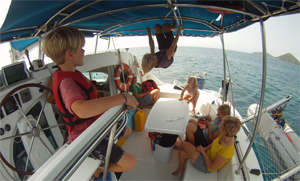 |
|
The Orton kids on Fezywig. |
|
Erik Orton |
OV: What type of life raft did you have?
EO: We chose not to have a life raft. Part of our rationale in buying a catamaran was the redundancy of two hulls. In consulting with longtime cruisers we trusted, they confided they would much rather take their chances with a semi-submerged boat than a life raft in open ocean. Plus, we did not plan to be in open ocean very much.
Anecdotally, we felt validated when we arrived in the Caribbean. A longtime cruising family with four children told us their experience with life rafts. They had migrated south to Grenada for hurricane season and set anchor there for a few months. They decided it was a good time to do a maintenance check on their life raft. To get a bulk rate, they rounded up a couple dozen life rafts from other cruisers and took them in to be serviced.
Since they were going to be repackaged anyway, they decided to test them. As they inflated their life rafts, half of them failed. Either the life rafts were faulty or not properly maintained. Regardless, we decided against relying on a 50-50 chance in a high-risk situation. We’d trust our two hulls and dinghy.
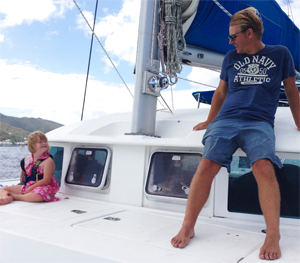 |
|
Erik with Lily, who wears a harness on deck. |
|
Ty LaMont Mecham |
OV: What did you have in your abandon-ship bag?
EO: Our first several months aboard, we did line-of-sight sailing between St. Martin, Anguilla, St. Barts, St. Eustatius, Saba and back to St. Martin. We made friends with other “kid boat” families and sailed together. During these short jaunts in company with other boats, an abandon-ship bag felt like overkill. This continued as we worked our way up the chain through the Virgin Islands and along Puerto Rico. When we finally left Puerto Rico and jumped to the Bahamas, we took it more seriously.
Since we didn’t have a life raft, an abandon-ship didn’t make a lot of sense. But abandon-ship bags are often called “ditch bags” and we did have “ditch” plans. We always knew where we would head if we ran into trouble. Crossing from Puerto Rico to the Bahamas, our ditch spots were Luperon in the Dominican Republic, the northern coast of Haiti and Guantanamo Bay, Cuba.
Once we reached Great Inagua and were headed to the Great Exuma chain, we identified ditch locations like Acklins Island and the fishing shoal in between. If we couldn’t get to our ditch spot, we would call for help via AIS.
The only time I’ve prepared a ditch bag was when helping race a boat from Annapolis to Bermuda. When sailing to Bermuda, there are no ditch spots. That boat was a monohull and had a life raft, EPIRB, inReach, radar and AIS. For me, each circumstance creates its own necessities.
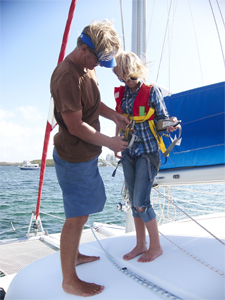 |
|
Erik helps get Jane ready to go up the mast. |
|
Ty LaMont Mecham |
OV: Did you have survival suits with you?
EO: No. Given the warm water conditions of the Caribbean, Virgin Islands, Bahamas and the U.S. East Coast in the summer, we didn’t think survival suits made sense for us.
OV: Did you have an EPIRB, PLB or a tracking/messaging device like an inReach or SPOT?
EO: No. In hindsight, I would have felt better if we had an EPIRB, but we were cruising on a shoestring. In that case I was probably penny-wise, pound-foolish.
OV: Did you have an AIS unit on board?
EO: Yes. Our VHF radio included AIS broadcasting and receiving, and included an emergency broadcast feature. Before we did our first overnight crossing from St. Martin to the British Virgin Islands, we replaced the low-range mast antenna with a functioning longer-range antenna. This gave us adequate distance to be in communication with other vessels underway as well as with land-based sources of help.
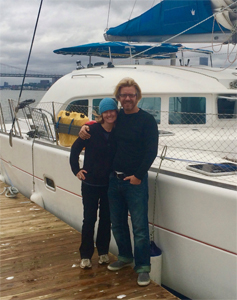 |
|
Erik and Emily with Fezywig tied up on the Hudson River. |
|
Jamie Anderson |
OV: What types of weather data did you use on your voyage? How did you gather weather information?
EO: We mostly listened to local forecasts on VHF and checked Weather Underground. We listened to weather broadcasts on cruiser networks in various locations as well as discussing varying weather reports with other cruisers we met along the way. As we got closer to hurricane season, we checked the National Hurricane Center (nhc.NOAA.gov) daily to stay aware of any developing systems. We studied anchoring for hurricanes and had a second anchor and additional lines for that purpose, but our preference was always to stay away from storms using a long lead time to be somewhere they would not be. That didn’t always work. We did sail through some squally weather. But, if a storm was coming our way, our strategy was to simply get out of its path if there was sufficient time or to stay at anchor.
After working our way up through the Caribbean, Virgin Islands, Bahamas and up the East Coast, we found ourselves sailing in the spin-off of Hurricane Bertha. As weather got nasty, we stopped for a few days into Charleston. Our original plan was to keep moving up the coast, but as Hurricane Cristobal developed, we decided to stay put. The storm system would pass east of us and hit Cape Hatteras. By staying put and farther west, we avoided the storm altogether.
I think one of the most underutilized safety features is time. If you’re racing to be in a certain place by a certain time to catch a flight, meet up with friends or some other deadline, safety often takes a back seat to punctuality. We found that by allowing time to be an asset, we avoided most problematic situations by simply getting out of their way or staying out of their way.
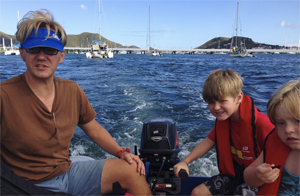 |
|
Eli learning to drive the dinghy under Erik’s watchful eye. |
|
Ty LaMont Mecham |
OV: Did you use a weather routing service?
EO: No. The only time we utilized a weather service was secondhand. We were on the island of Culebra, Puerto Rico. We’d just bought charts for the Bahamas and were making plans. We struck up a conversation with the boat anchored next to us and got to talking weather and routing. They subscribed to Chris Parker’s weather service and told us there was a fantastic weather window to the Bahamas starting the next day and continuing for three to four days. They recommended bypassing the Turks and Caicos and heading straight to Matthew Town in Great Inagua, Bahamas. We had never done a multiday crossing and this would be our longest by far: 500 miles. We would be crossing the Mona Passage between Puerto Rico and the Dominican Republic. Since it was notorious for rough seas due to deep underwater trenches on either side of the island chain and strong winds, we wanted flat conditions if at all possible.
This felt like a good window, so we went for it. We quickly sailed to Fajardo, Puerto Rico, provisioned, filled the fuel tanks and headed out within 36 hours of getting the weather info in Culebra.
Five days later, we arrived safely in Great Inagua in the Bahamas. We had seen some lightning, which was new to us and worrisome, but otherwise conditions were what we had hoped for: flat and boring.
The light conditions made for a fairly lethargic crossing, but we did not have to sail across the Mona Passage with our five kids in rough seas.
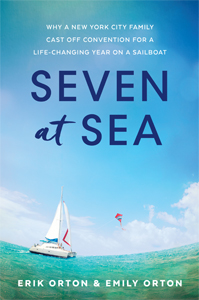 |
|
The Ortons’ memoir of voyaging on their multihull. |
OV: What were the challenges of voyaging with children aboard?
EO: When we moved aboard our Lagoon 380, one of our first projects was affixing netting around the lifelines of the boat. This became a telltale sign of a kid-friendly boat; if we saw other cruisers with netting, we hailed them and asked if they had kids aboard. The other project was tying jack lines down each side of the boat. We simply bought 1-inch flat webbing and tied each end to the deck eye hooks with water knots. Our initial safety rule was that while at anchor, the younger kids — who weren’t strong swimmers — had to wear life jackets anytime they were above deck. When we were underway, they had to be down below. During night watches, everyone had to wear life jackets and be clipped to jack lines. We relaxed this during smooth conditions as the months wore on. Jack lines were required at all times during night watches and foul weather. The kids eventually became strong swimmers and did not have to wear life jackets when at anchor.
Other than those initial safety concerns, traveling with our children was one of the best parts. From a practical standpoint, the teenagers provided more hands to help, including night watches.
We always paired up, so that created time where we got to visit one-on-one with each of our children and they learned new skills and increased in confidence. They all became proficient cooks and everyone contributed to meals, maintenance and crew responsibilities.
But for me, the most important outcome was that we became galvanized as a family. As far as safety was concerned, we knew we would never be able to account for every possible scenario. Walking out the door, let alone casting off the dock, carries inherent risk. We weighed those risks against the possible outcomes and decided it was something we wanted to do as a family.
Everyone in the family was on board. It wasn’t easy and we didn’t always get it right, but we’re glad we did it. As we say in our home, better done than perfect.
The Ortons’ book, Seven at Sea, was published by Shadow Mountain Publishing in March.

